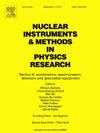Gas gaps and chambers quality control of improved Resistive Plate Chambers
IF 1.5
3区 物理与天体物理
Q3 INSTRUMENTS & INSTRUMENTATION
Nuclear Instruments & Methods in Physics Research Section A-accelerators Spectrometers Detectors and Associated Equipment
Pub Date : 2025-04-17
DOI:10.1016/j.nima.2025.170484
引用次数: 0
Abstract
In preparation for the Phase-II upgrade for the High-Luminosity LHC program, 72 improved Resistive Plate Chambers (iRPC) will be installed in the third and fourth endcap disks of the Compact Muon Solenoid detector during the annual technical stop 2024. This new generation of RPC detectors will operate in a low-angle momentum (extending RPC coverage from pseudorapidity = 1.9 to 2.4), in a high radiation environment, and will bring a better space and time resolution for this challenging region. To ensure proper performance, iRPC chambers undergo a series of quality control (QC) tests at each stage of the assembly chain. These tests include QC1 for the basic components, QC2 for chamber elements such as gaps and cooling, QC3 for evaluating the full chamber performance after production, which includes noise, efficiency, current, lastly QC4 for the final validation of the chambers. In this work we present the different QC stages and discuss test results for the newly built iRPCs at the assembly sites.
改进型电阻板腔气隙及腔室质量控制
为了准备高亮度LHC项目的第二阶段升级,在2024年的年度技术停止期间,将在紧凑型介子螺线管探测器的第三和第四个端盘上安装72个改进的电阻板室(iRPC)。新一代RPC探测器将在高辐射环境下以低角动量运行(将RPC覆盖范围从伪快度|η| = 1.9扩展到2.4),并将为这一具有挑战性的地区带来更好的空间和时间分辨率。为了确保适当的性能,iRPC室在装配链的每个阶段都要进行一系列质量控制(QC)测试。这些测试包括基本部件的QC1,间隙和冷却等腔室元件的QC2,生产后评估整个腔室性能的QC3,包括噪音、效率、电流,最后QC4用于腔室的最终验证。在这项工作中,我们介绍了不同的质量控制阶段,并讨论了在组装现场新建的irpc的测试结果。
本文章由计算机程序翻译,如有差异,请以英文原文为准。
求助全文
约1分钟内获得全文
求助全文
来源期刊
CiteScore
3.20
自引率
21.40%
发文量
787
审稿时长
1 months
期刊介绍:
Section A of Nuclear Instruments and Methods in Physics Research publishes papers on design, manufacturing and performance of scientific instruments with an emphasis on large scale facilities. This includes the development of particle accelerators, ion sources, beam transport systems and target arrangements as well as the use of secondary phenomena such as synchrotron radiation and free electron lasers. It also includes all types of instrumentation for the detection and spectrometry of radiations from high energy processes and nuclear decays, as well as instrumentation for experiments at nuclear reactors. Specialized electronics for nuclear and other types of spectrometry as well as computerization of measurements and control systems in this area also find their place in the A section.
Theoretical as well as experimental papers are accepted.

 求助内容:
求助内容: 应助结果提醒方式:
应助结果提醒方式:


